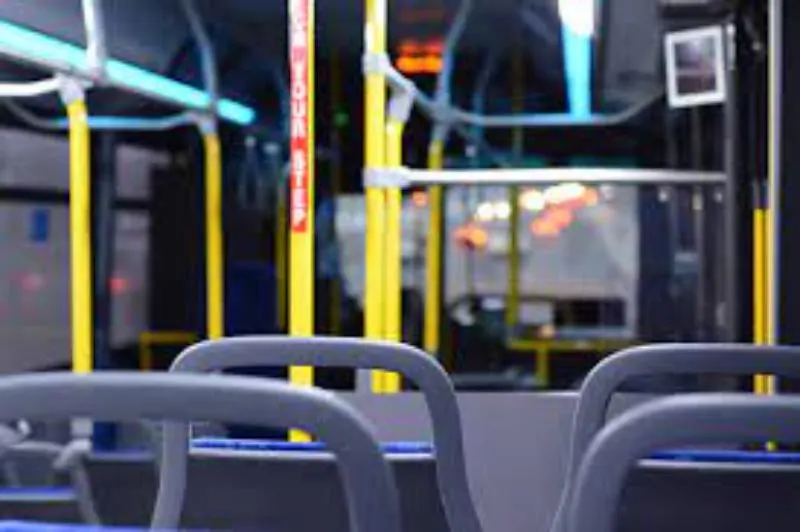Journey with us as we deep-dive into the vivid realm of motor coaches — charter buses! Imagine this: plush reclining seats, wide panoramic windows, and all the wonders of the road — an enticing blend of comfort and adventure.
In this ultimate guide, let’s strip down the steel curtains to unfold the mystery of what charter buses are and how they operate. Buckle up readers because truth can be stranger than fiction when you navigate through the highway of knowledge on charter buses!
A charter bus is a private vehicle rental used by groups for transportation to their desired destinations. It offers the flexibility to customize itineraries, usually includes amenities like a driver, undercarriage storage space, onboard bathrooms, and free WiFi. Charter buses are popular for their cost-effectiveness, convenience, and ability to provide a bonding experience for group travel.
Table of Contents
Understanding Charter Buses

Charter buses refer to private vehicles rented by individuals or groups to take them to their destination. It allows groups to customize their itinerary and typically features perks like a driver, undercarriage storage space, onboard bathrooms, and free WiFi. Charter buses have been used for transportation since as early as 3000 B.C.E., but modern coach buses as we know them today got their start in the early 20th century.
Think of charter buses like renting a private car or limousine for group travel or events rather than relying on public transportation. Now that we understand what charter buses are let’s explore how they have evolved over time since the first charter bus services were established in the early 1900s.
Evolution of Charter Buses

The first motorized omnibus was invented in 1895 by Emile Busnot in France, making public transportation more convenient and comfortable than horse-drawn vehicles. However, chartering wasn’t possible until around the 1920s when charter bus service businesses started to form. These carrier companies acquired or built new vehicles designed for longer trips, thus offering people greater flexibility when traveling.
One such company was the Greyhound Lines, which began operating in 1914 with a single Hudson bus route from Hibbing, Minnesota to Alice, Minnesota for miners needing transportation. The company later expanded rapidly and would eventually become synonymous with long-distance travel throughout North America.
Today, there are different types of charter buses available depending on the size of the group and specific needs. These include coach buses (for 30-55 riders), mini-coach rentals (for 28 riders or less), school buses (for 30-47 riders), minibuses (for 21 riders or less), and sprinter vans (for 8-15 riders).
Despite the many upgrades and customization options available to customers, the charter bus industry still experiences challenges such as high overhead and low returns. The cost of a new charter bus can range from $500,000 to $600,000, making it difficult for small and medium-size businesses to acquire their fleet. Operators must also pay property tax, registrations, and permits on top of fuel costs. Furthermore, with drivers’ wages being a significant expense for companies, finding qualified drivers who meet regulatory criteria is becoming more challenging.
Now that we’ve explored what charter buses are and their evolution let’s delve into different types of charter buses that exist today.
● According to a 2019 survey, 39% respondents in the U.S have used a charter bus at least once.
● The American Bus Association reported that the charter and tour industry serves over 600 million passengers annually.
● As of 2024, the global charter bus services market value is expected to cross $30 billion, growing at a CAGR of more than 5% during 2020-2025.
● The charter bus industry has a long history, starting with the invention of the first motorized omnibus in 1895. Charter bus service businesses began to form in the 1920s, offering greater flexibility and comfort for longer trips. Greyhound Lines, which started in 1914, became synonymous with long-distance travel in North America.
Today, there are various types of charter buses available, including coach buses, mini-coach rentals, school buses, minibuses, and sprinter vans. These options cater to different group sizes and specific needs.
However, the charter bus industry still faces challenges. The high costs of acquiring new buses make it difficult for small and medium-size businesses to expand their fleet. Operators also have to deal with overhead expenses such as property tax, registrations, permits, and fuel costs. Additionally, finding qualified drivers who meet regulatory criteria is becoming more challenging. Despite these challenges, charter buses remain a popular mode of transportation for many travelers.
Types of Charter Buses

There are several types of charter buses available for rental, depending on the group size and specific needs. These include coach buses (for 30-55 riders), mini coach rentals (for 28 riders or less), school buses (for 30-47 riders), minibusses (for 21 riders or less), and sprinter vans (for 8-15 riders).
Suppose you’re transporting a large sports team to an out-of-state competition; a coach bus would be your best option to provide enough space for players, equipment, and luggage. Conversely, if your job requires you to transport a small group of VIPs, perhaps a luxury minibus rental that provides comfort and privacy would be ideal.
When choosing the bus type, consider factors like trip length, passenger comfort requirements – like legroom – , baggage requirements, and the need for special amenities like WiFi. This can help ensure your ride is comfortable and satisfying.
Advantages of Renting a Charter Bus

Charter buses continue to offer numerous benefits over traditional ground transportation methods. For one, they offer cost-effectiveness. Renting a charter bus is usually more affordable than other transport options available for large groups like trains or planes.
Secondly, renting a charter bus provides an excellent bonding experience for family gatherings, company retreats or students traveling on field trips. Everyone travels together, allowing ample opportunity to socialize during travel time.
Thirdly, operating on a convenient schedule, charter buses allow flexibility in customizing itineraries based on the needs of the renter.
Fourthly renting a charter bus ensures societal responsibility as it reduces traffic congestion by putting fewer cars on the road. Moreover, they have greener sustainability trends than other vehicles by using fuel-efficient technologies reducing their carbon footprint.
Finally, renting a charter bus is made easy with online booking tools like Bus.com’s website, where you can quickly compare quotes, view bus photographs and amenities in real-time.
It’s similar to choosing a ride-sharing app over hailing a taxi. There are more benefits involved through automation, affability and customized itinerary defined according to the customer’s needs.
By renting a charter bus, travel is demystified as concerns of safety, comfort is taken care of leaving the passengers free to explore other fun trip activities. The results are increased productivity, engagement experiences and less stress.
See Related: Tips for Bus Tours & Travel
Cost Efficiency and Versatility
Charter buses are perfect for groups traveling together over an extended period. Unlike public transport, charter buses allow groups to personalize their itinerary and pick up and drop off locations. This feature saves time, money, and stress in planning group travel. When comparing ticket prices for plane, train, or even personal cars with fuel expenses for group transportation, charter buses prove to be the most cost-effective mode of transport.
Think of group travel like going to Costco; it’s more beneficial cost-wise to buy in bulk than to purchase individual products at a higher price. Additionally, since charter buses can carry large groups at once, they’re more environmentally sustainable and can significantly decrease traffic on roads.
Regarding versatility, there are several types of charter buses available depending on the size of the group and specific needs. These include coach buses (for 30-55 riders), mini-coach rentals (for 28 riders or less), school buses (for 30-47 riders), minibuses (for 21 riders or less), and sprinter vans (for 8-15 riders). With these options, travelers can select the ideal bus for their itinerary rather than be forced to work within predetermined schedules.
Comfort and Safety Features

Charter buses offer unparalleled safety features that make them highly sought-after compared to other modes of transportation. Every reputable company must comply with federal regulations overhauling every six months before a trip is licensed. Robust driver training protocols plus regular drug testing policy ensure drivers remain alert throughout a journey.
Most importantly are the technological safety features showcased — anti-lock brakes, stability control systems, motion sensors, lane-departure warnings –– ensuring the safe arrival of all travellers. Furthermore, modern buses come equipped with all manner of comfort enhancing amenities to maximize ride pleasure. High-quality air conditioning vents evenly distribute chilled air throughout the cabin during hot or humid weather. Ample space for personal goods decreases clutter, giving passengers more freedom to move around.
Luxury buses come equipped with spacious reclining seats to reduce fatigue during extended trips. Wide floor aisles ensure the aisle isn’t crammed and congested. Flatscreen TV screens adorn the walls, keeping everyone entertained during long journeys. Onboard lavatories allow passengers quick access to washrooms without having to continually stop.
While such amenities may not be necessities, they can positively contribute to the travel experience, making it more relaxed and enjoyable.
Financial Challenges in the Charter Bus Industry
Although charter buses are a popular and cost-effective option for group travel, the charter bus industry is not immune to financial challenges. The cost of running a charter bus business is high, and several factors can addto the strain. One of the most significant financial challenges facing the charter bus industry is overhead costs and profit margins.
Overhead Costs and Profit Margins

Like any business, charter bus companies have operating expenses that factor into their profit margins. These expenses include the cost of maintaining a fleet of vehicles, insurance, fuel costs, employee salaries, taxes, and more.
The cost of a new charter bus can range from $500,000 to $600,000. Depreciation rates are high, resulting in most companies being upside down on their loans for the coaches. Property tax, registrations, and permits are also expensive. Furthermore, charter buses typically have fuel tanks of 200 gallons or more, costing over $1000 to fuel the bus. Fuel costs alone are approximately $1 per mile.
But it’s not just about fuel costs; maintaining the buses routinely by mechanics is another important aspect. Spare parts and maintenance for heavy-duty vehicles can be pricey as well. Charter carriers are required to carry at least $5 million dollars in liability insurance and collision insurance on the coaches.
These rising costs due to market forces such as inflation or fluctuating economies like during the pandemic affect small family-owned charter businesses that make up most entities within this industry. With drivers’ wages increasing due to regulations and labor costs plus limited driver availability resulting in lower fleet capacity – additional pressure is created on maintaining profit margins.
Think of it like running any other enterprise – managing high overhead costs while staying profitable amidst market changes can be challenging.
Whether considering booking a private group travel or charter bus for special events, contracted rates rather than repair and fuel expenses should be discussed. As a customer, it’s also important to be aware of potential hidden fees that may surface at the end of a trip.
The Future of Charter Bus Operations
The charter bus industry has come a long way over the past decades with several advancements in technology and procedure. From GPS tracking systems, onboard WiFi, USB charging ports, and luxury amenities like leather seats and flat-screen TVs, today’s charter buses offer more than just transportation. In recent years, eco-friendly hybrid charter buses have become increasingly popular, subtly introducing sustainable practices into the industry. However, challenges such as rising fuel costs and strict regulatory requirements remain on the horizon.
Take for instance, the impact of COVID-19, which has significantly impacted the industry across the world. As health concerns continue to influence people’s transport decisions, the demand for isolated transportation options like charter buses is expected to rise.
Despite navigating complex issues like these, the future of charter bus operations is still ripe with opportunities. There is boundless potential in leveraging technological advancements like data analytics tools to monitor route efficiencies and pricing strategies tailored to meet customer needs better.
Think of it like adopting new practices in any other business – innovating or adapting to change can help organizations achieve substantial growth over time.
Data-driven management solutions have already begun creating a positive impact within the industry by enhancing operational efficiency and improving passenger experience. These digital updates will continue driving change from behind-the-scenes, working their way throughout all public spaces on board for interactions that enhance safety protocols (such as contact tracing) and reduce unnecessary risks from shared surfaces.
Ultimately, the future of charter bus operations rests in finding ways to build upon its present success while making it more inclusive and accessible—together adapting to changing circumstances as needed. As businesses face competition amid new players entering this market space daily – with varying levels of background knowledge on regulations around different states – your fleet choices might need revisions to stay abreast of evolving trends so that they remain successful over time.
Related Resources:
